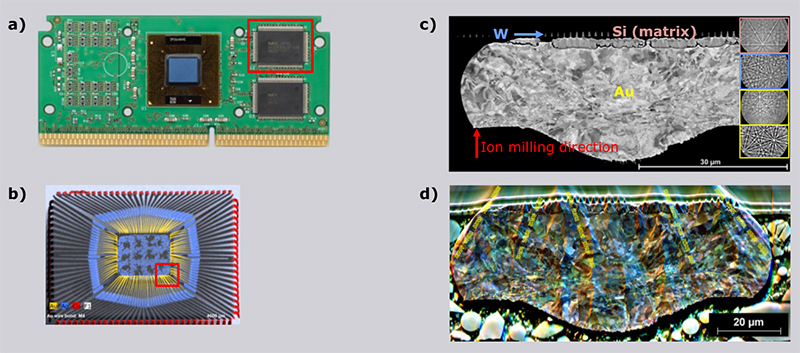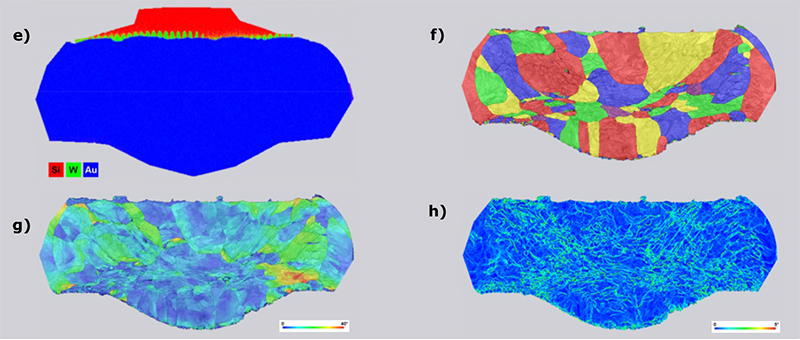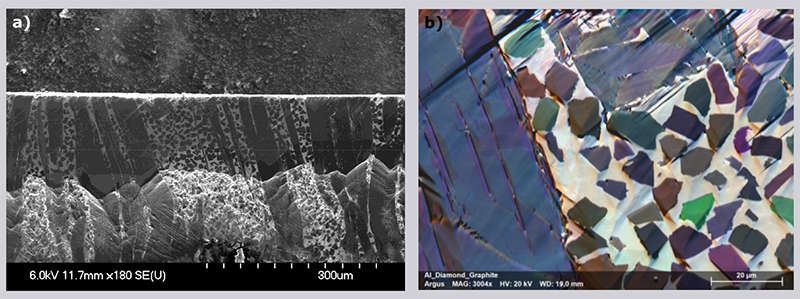Electron Backscatter Diffraction technique (EBSD) is known as a “surface” technique because electron diffraction is generated within a few tens of nanometers of the sample surface. Therefore, the specimen surface should be exempt of any damages in order to produce EBSD patterns. Here, we present a successful and efficient EBSD sample polishing of two very challenging specimens prepared by broad ion milling

a) TXP: 20 min b) TIC 3X: 3 h - Au, 6 h - Al/C
Fig. 1(a) At first, a mechanical pre-preparation is performed using the Leica TXP (cross sectioning) to approach the area of interest
in a very short time. Fig.
1(b) Then, with the Leica TIC 3X (broad ion milling) a perfect cross-section surface is achieved, which is ready for EBSD analysis.

Fig. 2 (a) Computer processor used for this application.
(b) XRF analysis of the processor . The area of interest is highlighted in red. The EBSD analysis was conducted on the gold wire only ,
where it is highly deformed.
(c) BSE image of the area of interest revealing a well prepared surface after the site specific preparation conducted by TXP and TIC 3X;
and EBSD patterns of the different areas, from top to bottom: Si, W , deformed Au and less deformed Au.
(d) The ARGUS color-coded FSE image reveals some curtaining effect, which directions are highlighted in yellow.

Fig. 2 (e) EDS HyperMap from simultaneous EBSD/EDS analysis.
(f ) EBSD grain size distribution in random color (98% indexing rate on Au).
(g) Misorientation average map showing the strain localization.
(h) Misorientation kernel map. None of the maps show an effect of the curtaining (there is no structure following the curtaining effect):
it confirms that broad ion beam milling do not introduce noticeable sub-surface damages.






Fig. 3 (a) SE image of the sample - overview.
(b) ARGUS FSE/BSE image after preparation using TXP and TIC 3X: it reveals a perfect surface preparation on both the
graphite flakes (on the left), the aluminum matrix and the diamond grains.
(c) EBSD patterns of the different phases.
(d) Overview of the prepared surface (in total 3mm were polished).
(e) Pattern quality map of the EBSD/EDS analysis.
(f ) EBSD Phase map showing the high indexing rate, even on the graphite flakes. Graphite is displayed in blue, diamond in red
and aluminum in green.
(g) Corresponding EBSD orientation map along the X axis.
While the Focused Ion Beam technique is often used for site specific sample preparation, it usually prevents from a successful EBSD analysis by introducing sub-surface deformation and curtaining especially on multiphase material. In this example we have demonstrated that broad ion beam milling allows to simultaneously polish both hard and soft material. The combined use of the Leica TXP and TIC 3X allows to perfectly prepare large areas of very challenging samples within a short time.
[1] Gang Ji et al. , Materials Characterization, Vol. 89 (2014),132-137
High Quality Sample Preparation for EBSD Analysis by Broad Beam Ion Milling